Ekaterinburg through the eyes of a visitor or 5 years after the first acquaintance
It seems that there were no articles about Ekaterinburg yet, and I decided to fix it, because this city is often mentioned in comments to similar articles. Many live in their cities and enjoy life. Get used to them. Sometimes they have nothing to compare. I happened to visit many Russian cities and have something to compare with and, as a person who moved to Yekaterinburg, I want to write about what awaits you if you come [to live] to this city.
Carefully, under the cut pictures.
Ekaterinburg was founded in 1723, i.e. It is not a very old city, but it is not a young city that would be founded or become large in the Soviet years. In 1917, 71,590 people lived in the city, and during the years of the civil war, the population not only did not decrease, but also grew to 91,000 people (a rare achievement in those times). In Yekaterinburg, a large number of buildings of pre-revolutionary construction, and most of the surviving ones are made of bricks, although wooden architectural monuments are also not uncommon.
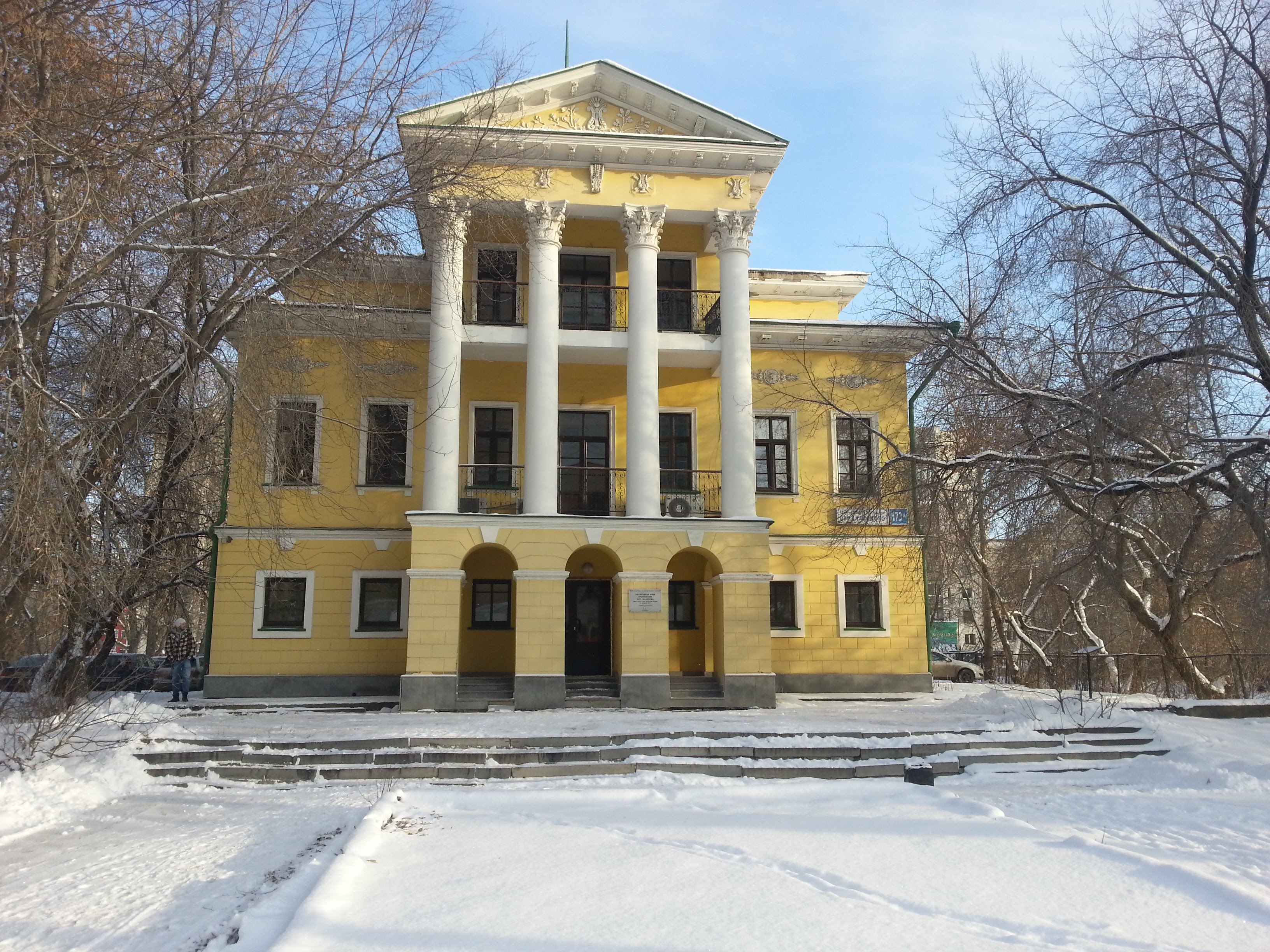

This moment can be called positive for lovers of old architecture. It makes sense to come to the city even as a tourist, if you like architecture. But, as usual, the pros and cons are rarely separate, and the disadvantages here are the following: old buildings are regularly demolished, even if they are in a satisfactory condition. And then, worse, on the site of an old building on a street with a two- or three-story building can safely stick a 15+ storey candle. And why, actually, no?


Or maybe on the other side of the street everything is built up with skyscrapers of the beginning of the 20th century? No, there is such a "lamp" building of the Ural Mining Institute of red brick.
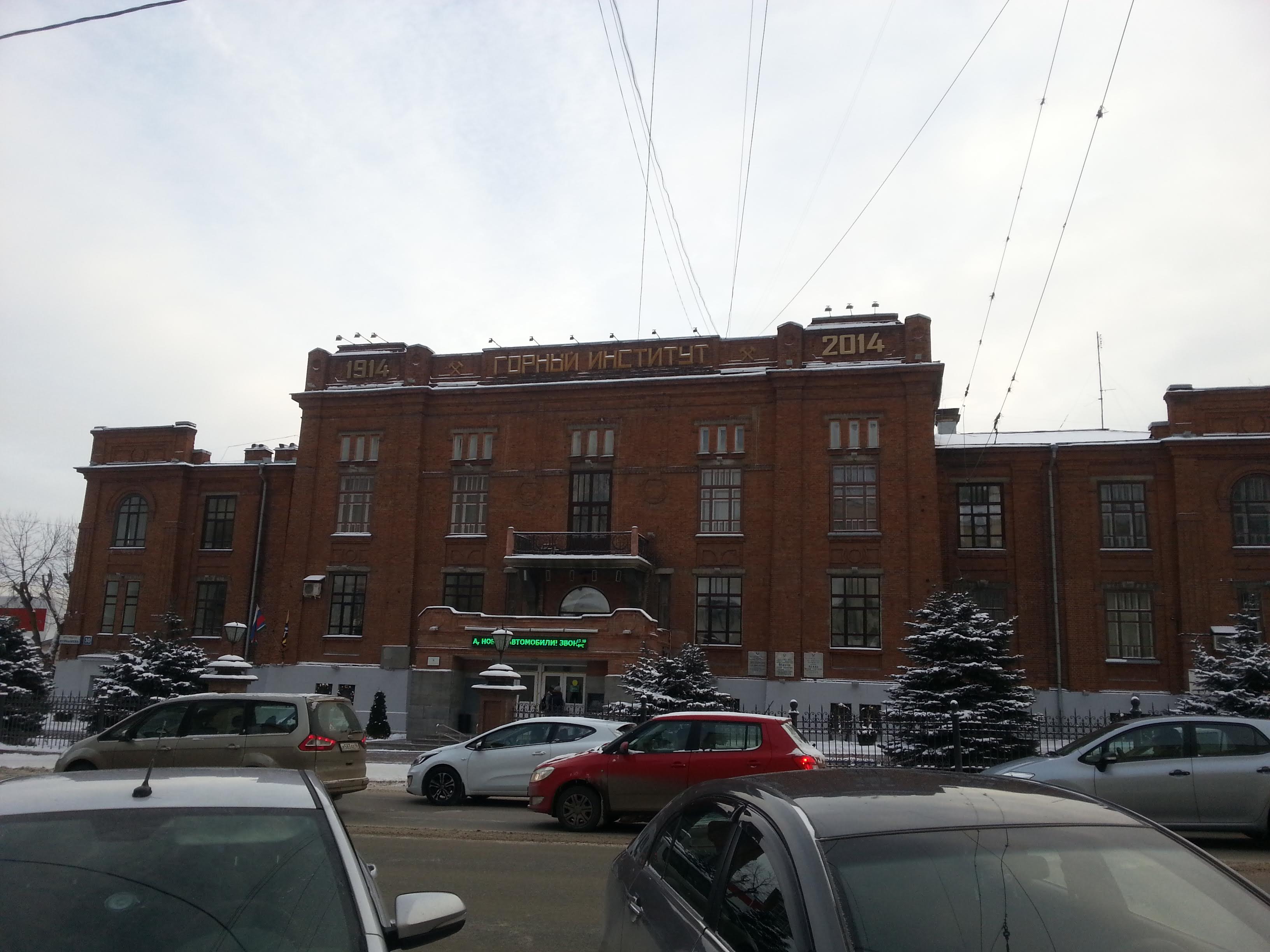
By the way, about the red brick. In the city, they love and respect him, and today they often make such monsters out of it that look like a prison for VIP.

Put a candle in 50+ floors? The same can be the same (Vysotsky tower is a confirmation of this).
This leads to traffic jams and traffic jams and kills the historic part of the city.
habr.com/post/428826/#comment_19426564
Sometimes it seems to me that the official who issues building permits is either incompetent or unclean. For example, a narrow alley leads to this house. After it is handed over, and people are settled, there will be a pipets twice a day.
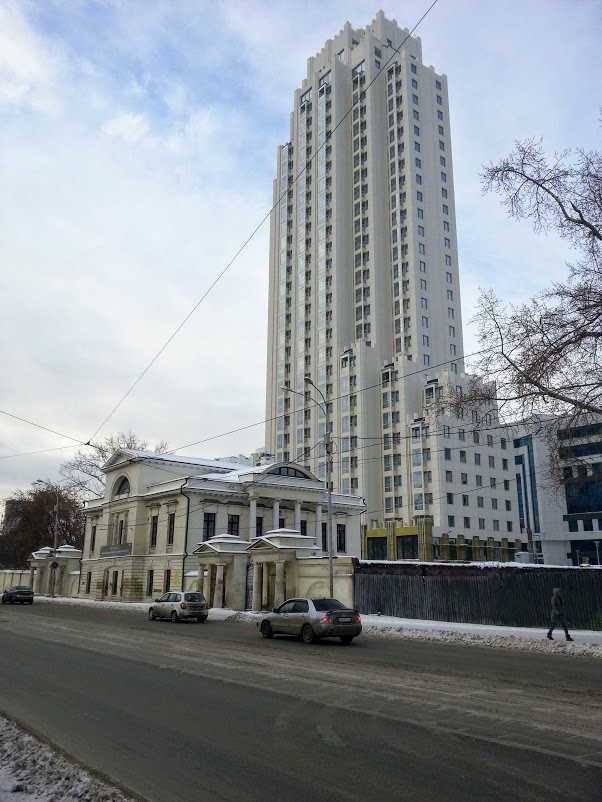
What to go far! Once they decided to rebuild the old Passage next to the building of the city Duma. The officials who watch over the construction, carefully counted the number of floors, made sure that there are less floors than the Duma, and gave the go-ahead. As a result, the “renewed” Passage became higher than the Duma. And no one looked at the height of the floors ... and, it seems, these unfortunate officials forgot to count the attic. By the way, he borrowed the facades from the old Passage (pay attention to the left side of the photo, next to the transition gallery), and I had the first association as if I was watching the film “Men in Black”, and then a certain alien pulled on Edgar’s skin . Alas, this is quite common in Yekaterinburg.
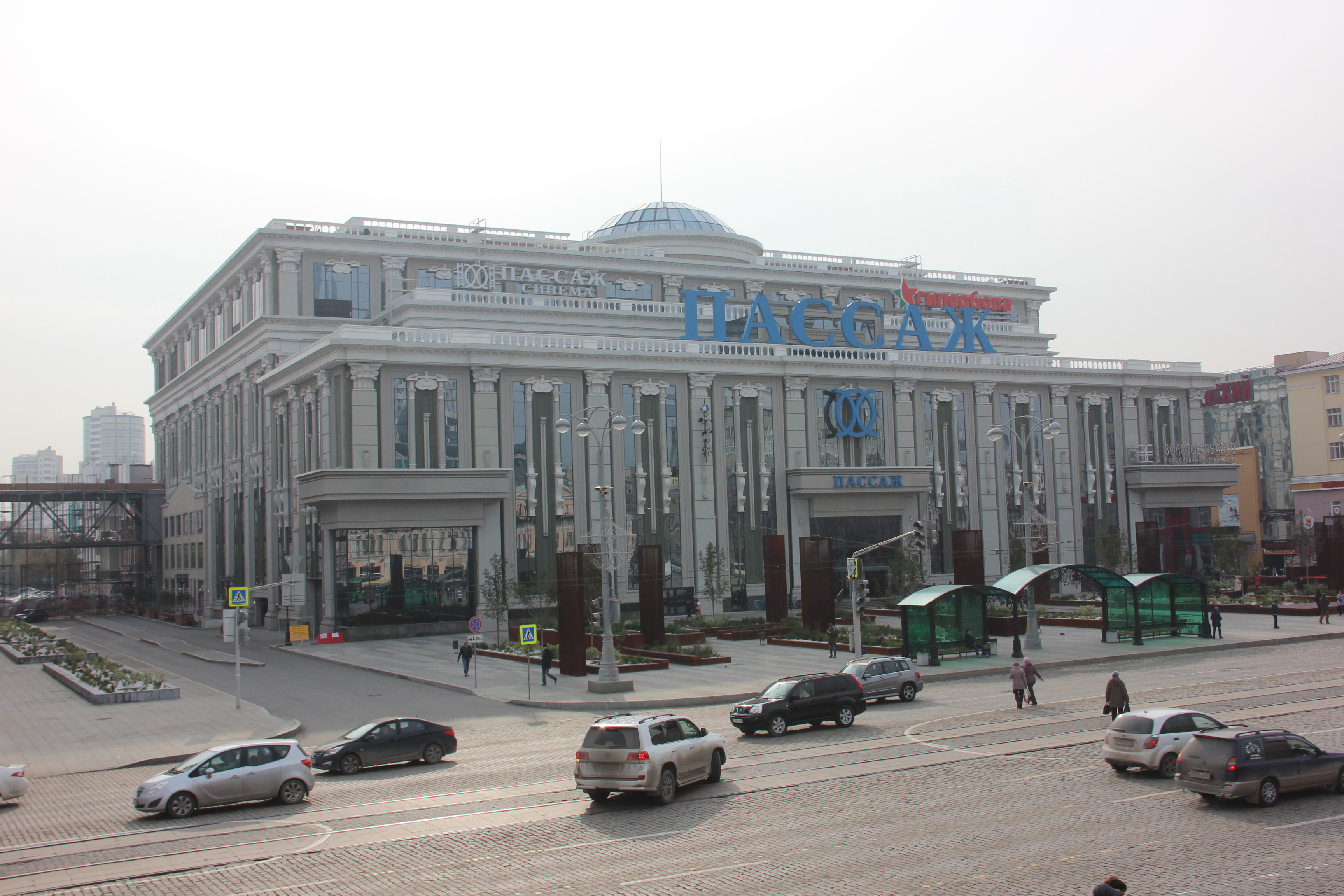
(The authorship of the photograph is not indicated, I have taken it from the website Our Newspaper)
The city is considered relatively compact, with over 1,450,000 people living in it, and the population is growing. In terms of population, the city is inferior, in an understandable way, to Moscow and St. Petersburg, as well as to Novosibirsk. The central part of Yekaterinburg was built according to a strict plan, and the city in the center has a rectangular layout. In the new parts of the city, other options are also used - for example, in the northern part of the city (Uralmash and Elmash districts) radial-ring layout is used. The city has a subway, one branch of which connects the city in the meridional direction, connecting the central and exit to the southern part of the city and the northern areas of the city. The city is actively being built (Akademicheskiy, Shirokaya Rechka, Solnechny) and new people are coming and going to the city - most of them from the Sverdlovsk region (the local residents call them “regionalist” with extremely negative coloring) some of the adjacent regional centers (Tyumen, Chelyabinsk, Kurgan), people go from Kazakhstan (but to a lesser extent). However, for locals, all visitors by default are “regionalists” (with the exception of guests from Central Asia). An interesting moment with immigrants and workers from Kazakhstan is that most companies do not know how to apply for foreign labor resources even from the EEU countries. On the other hand, the city is simply flooded with migrants in those positions that do not seem very attractive to the local population: janitors, trade, drivers and conductor of minibuses, security, cleaning, construction - all of them are occupied by people from various solar republics. It is understandable - the average salary in the city is about all visitors by default are “regionalists” (with the exception of guests from Central Asia). An interesting moment with immigrants and workers from Kazakhstan is that most companies do not know how to apply for foreign labor resources even from the EEU countries. On the other hand, the city is simply flooded with migrants in those positions that do not seem very attractive to the local population: janitors, trade, drivers and conductor of minibuses, security, cleaning, construction - all of them are occupied by people from various solar republics. It is understandable - the average salary in the city is about all visitors by default are “regionalists” (with the exception of guests from Central Asia). An interesting moment with immigrants and workers from Kazakhstan is that most companies do not know how to apply for foreign labor resources even from the EEU countries. On the other hand, the city is simply flooded with migrants in those positions that do not seem very attractive to the local population: janitors, trade, drivers and conductor of minibuses, security, cleaning, construction - all of them are occupied by people from various solar republics. It is understandable - the average salary in the city is about On the other hand, the city is simply flooded with migrants in those positions that do not seem very attractive to the local population: janitors, trade, drivers and conductor of minibuses, security, cleaning, construction - all of them are occupied by people from various solar republics. It is understandable - the average salary in the city is about On the other hand, the city is simply flooded with migrants in those positions that do not seem very attractive to the local population: janitors, trade, drivers and conductor of minibuses, security, cleaning, construction - all of them are occupied by people from various solar republics. It is understandable - the average salary in the city is about45 thousand rubles. Nobody will go to depressive places - neither their own, nor others.
As for ecology, I should note that in the north of the city there is a smell of industrial emissions into the atmosphere from the adjacent satellite town of Verkhnyaya Pyshma, in the northeast there are nice places like Isoplit (I don’t know how alive and harmful production there is), eastwards the largest Novosverdlovskaya CHPP and the picturesque ZHBI area, just south of it is “Poultry Farm”, in the southeast direction there is a microdistrict with the harmonious name Khimmash, almost strictly in the South there is a microdistrict Elizabeth, which is on the pollution map air also looks "not very."
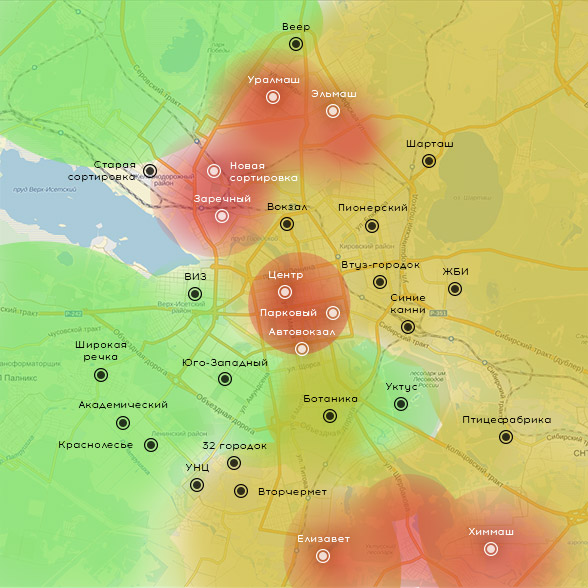
the origin is unknown
The air is polluted and omniscient dust, which in the offseason looks like streams of natural dirt. Sources of dirt? Mud on private carriages, construction equipment and trucks, streams flowing onto the roads from lawns in rainy weather, and later, in winter, a certain chemical “Bionord” (TM) that prevents it from finally freezing.
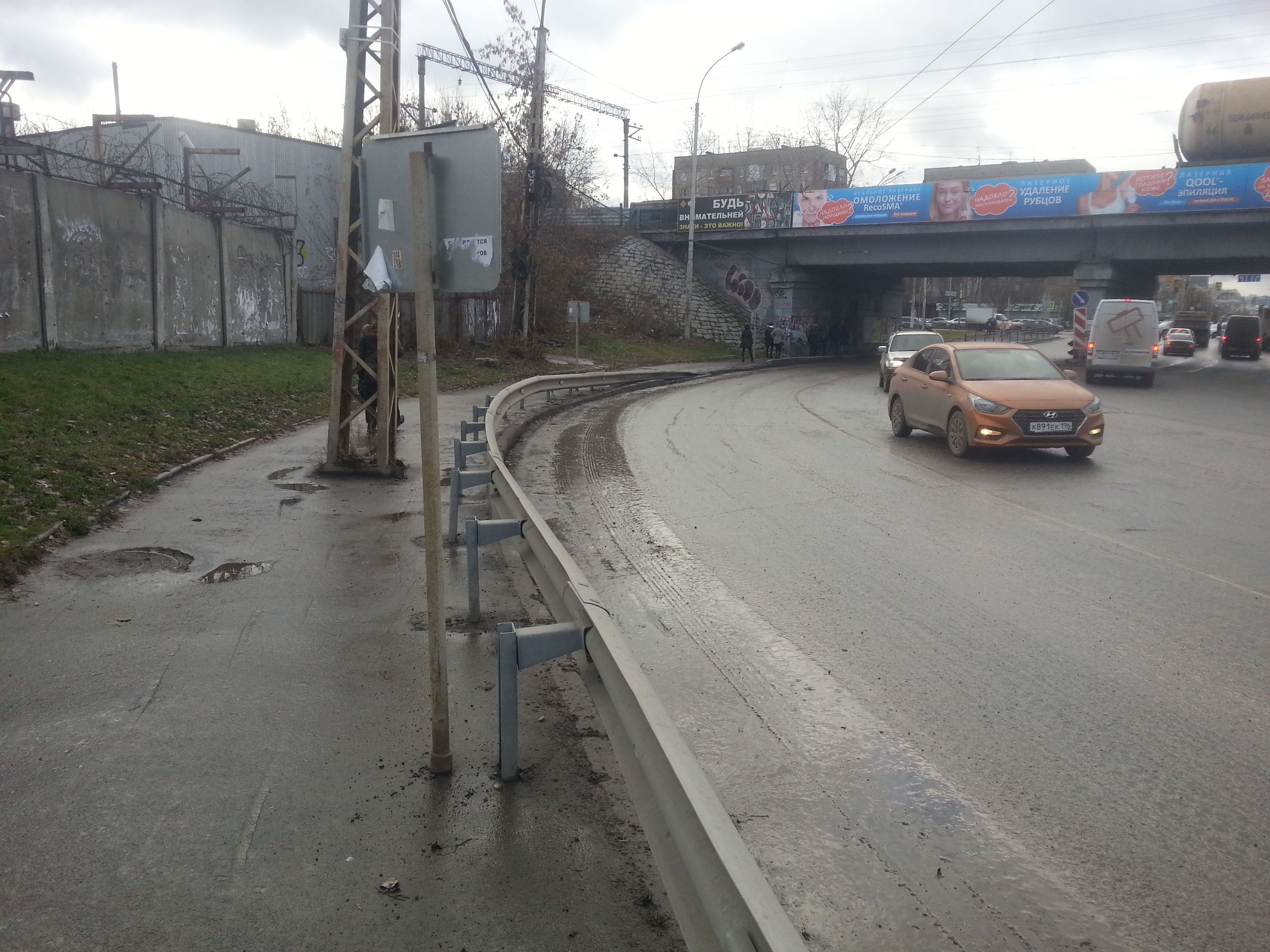
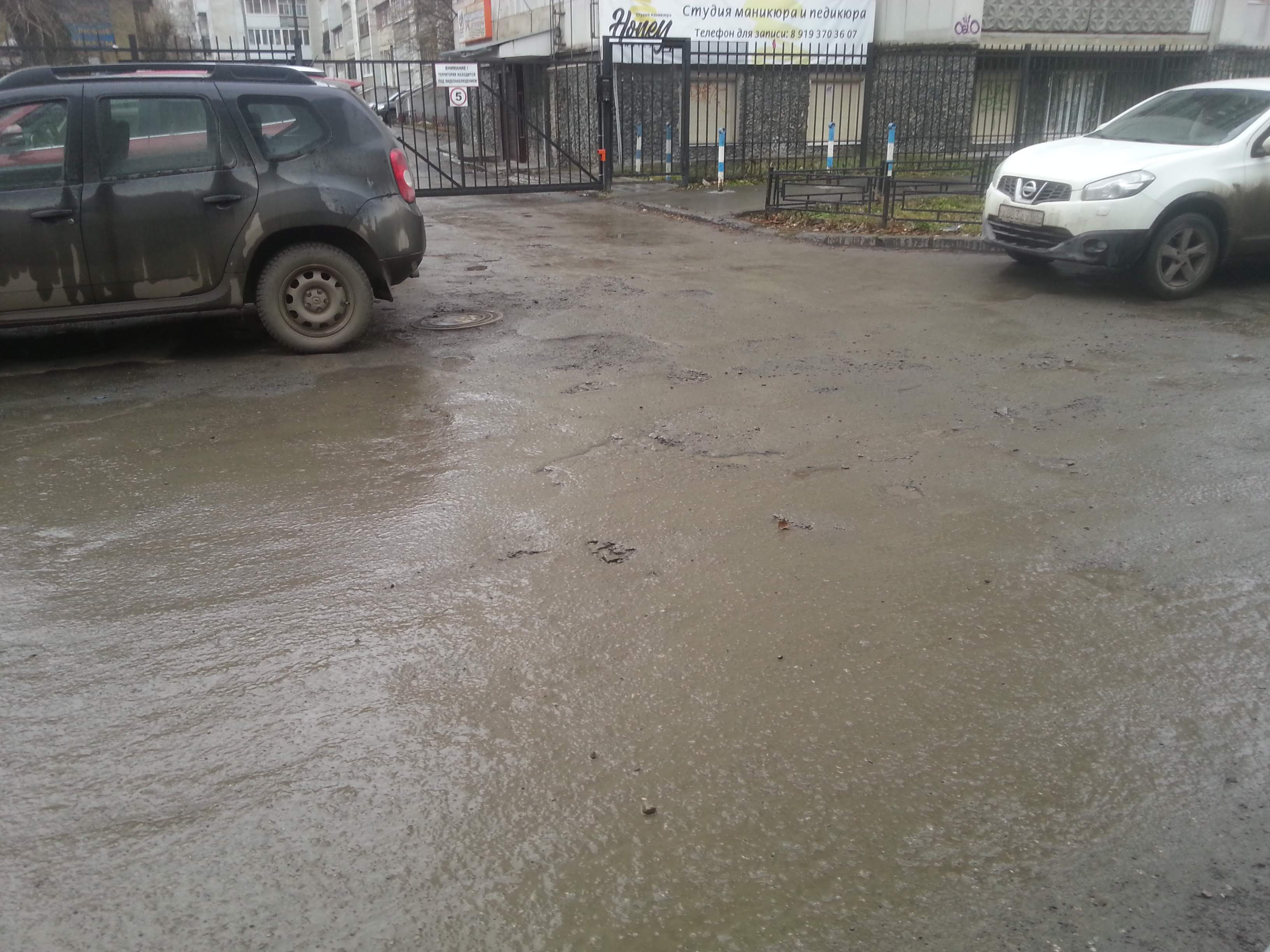
As the former mayor is already joking - the locals have “mud in the soul” (see more photos of #drink). The rest of the townspeople, with the exception of the former mayor, are divided into two types: the former prefer not to notice, the latter call the city “Gryazburg”.
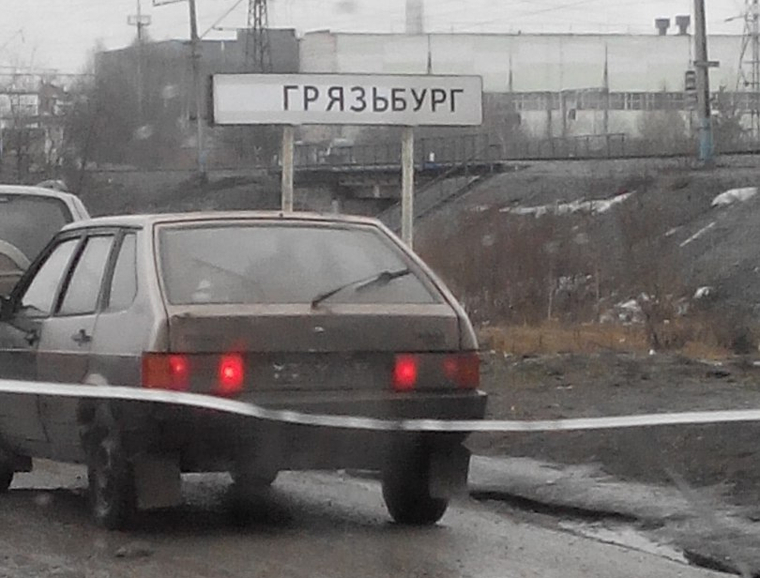 Photo by Irina Shantarina.
Photo by Irina Shantarina.
However, another group of citizens is actively fighting with the latter for the right to glue the plates 5.23.1 with another inscription - “Yamburg”. Some roads (very large including even those connecting adjacent areas) in the city did not see repair since the days of their arrangement. Sometimes those and other activists are taken away by valiant law enforcement officers. By the way, about the rule of law - theft is booming. Especially often steal great. Often there are arson cars. Still, it happens that old houses are burned (for construction, see above), activists are beaten from time to time and they kill just random people. In general, life in the Urals is quite tough, if not to say cruel. About traffic police - they have a couple of favorite places where they “graze”, mostly behind signs 40 km / h. Very rarely, cars from under signs are evacuated from just a few streets. Roads are like normal somewhere, somewhere they remind a washboard (the right lane especially suffers, as an example - Furmanov Street when driving from East to West), somewhere there is a hole in the pit. Lots of cameras. There will be even more. Pedestrians need to turn their heads, but, in general, they pass on unregulated passages (but there will definitely be someone who does not miss it). Some traffic lights are not working, regularly, someone walks right under the wheel or tightly / significantly blocks the intersection while driving, not guessing with the mode of its operation. who will not miss). Some traffic lights are not working, regularly, someone walks right under the wheel or tightly / significantly blocks the intersection while driving, not guessing with the mode of its operation. who will not miss). Some traffic lights are not working, regularly, someone walks right under the wheel or tightly / significantly blocks the intersection while driving, not guessing with the mode of its operation.
Cold water in the city, in different places, ranges from "it is necessary to boil" to "we buy water in the supermarket." I myself live in the center, I buy water in the supermarket. Hot water, where it is, ranges from "good" (this is where water is heated from its own well) to "bad." By bad, I mean incredibly stinking water (and / or brown) that is unpleasant to wash. So far I have not been lucky, and in two of three places the water was just that - smelly. With water quality, in general, everything is bad. Plus, I can note the relatively short seasons off hot water (depending on the area). Boilers here in the apartments set very rarely.
Remote work is good, but what is there to do in Ekaterinburg from work, let's say local? The largest IT employers are just a few firms. The first one is SKB-Kontur. With about 10,000 employees, it has about 1,000 programmers and N hundreds of other IT people. Next - Sberbank (and Sbertech). I don’t know how many developers work in it, but they always openly have 50 or more vacancies for IT specialists of various kinds. Other banks are trying to keep up - UBRD holds open from 20 to 30 vacancies. It may be noted SKB Lab, Point. Other local banks also hire developers. However, what am I talking about only banks? In addition to banks, the city has developed industry (or rather its remains), a little more than this industry in the surrounding satellite cities, so if you are friends with microcontrollers, Simatic and Step7 you do not seem to be the names of programs for weight loss - there is also something to do here. There are other purely IT offices - Naumen, Targem Games (yes, guys make games!), Jet style, Yandex has a small office in the city, INSIS and so on. By the way, for those who would like to try themselves in telecom, MegaFon has a large center of several competencies in the city: Oracle DBA, Unix admins, small RnD teams from large divisions, DWH and others.
The median salary in the city among IT specialists is about 70 thousand rubles. In life, as always happens more, it happens less. Moreover, for the same duties in different companies can pay twice, or even three times different money. But in general, in terms of wages in IT Co., this is not Moscow or St. Petersburg.
On the pedestrian street Weiner, in the heart of the city, there is a local hackspace MakeItLab. The guys are doing cool stuff. They are located in a modest mansion.
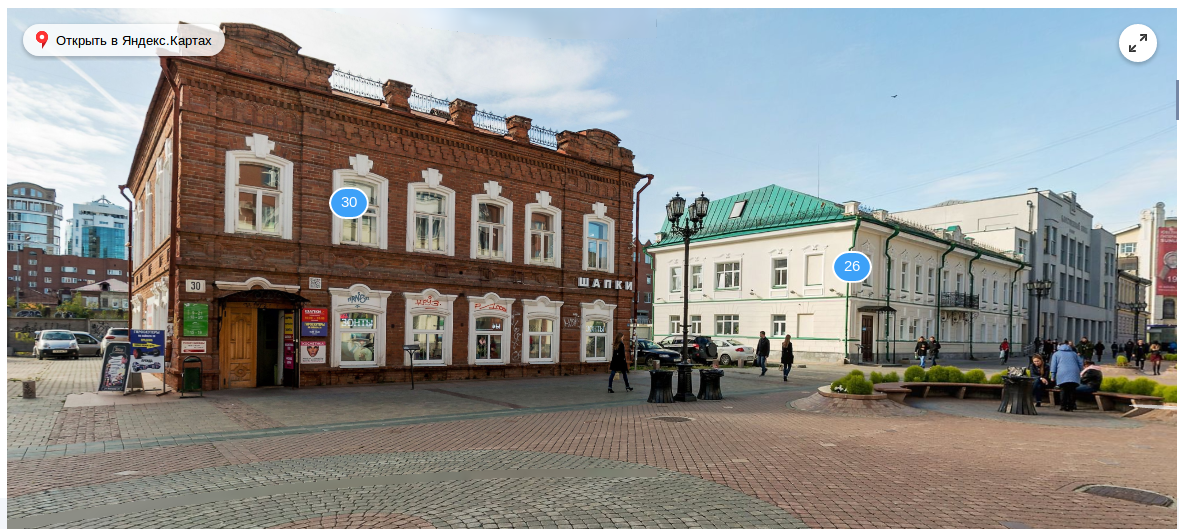
Yandex Photo
Culturally, the city is quite rich. The first city theater was built in 1845 of brick and still stands, an excellent building pleasing the eye. Several theaters. Different groups come regularly. There are always interesting announcements on posters. The city hosts the annual rock concert "Lighthouse". There is a philharmonic society (and there is even an organ in it! It's amazing). There are a number of museums. My favorite where I always lead people is the Museum of the History of Stone-cutting and Jewelry Art.
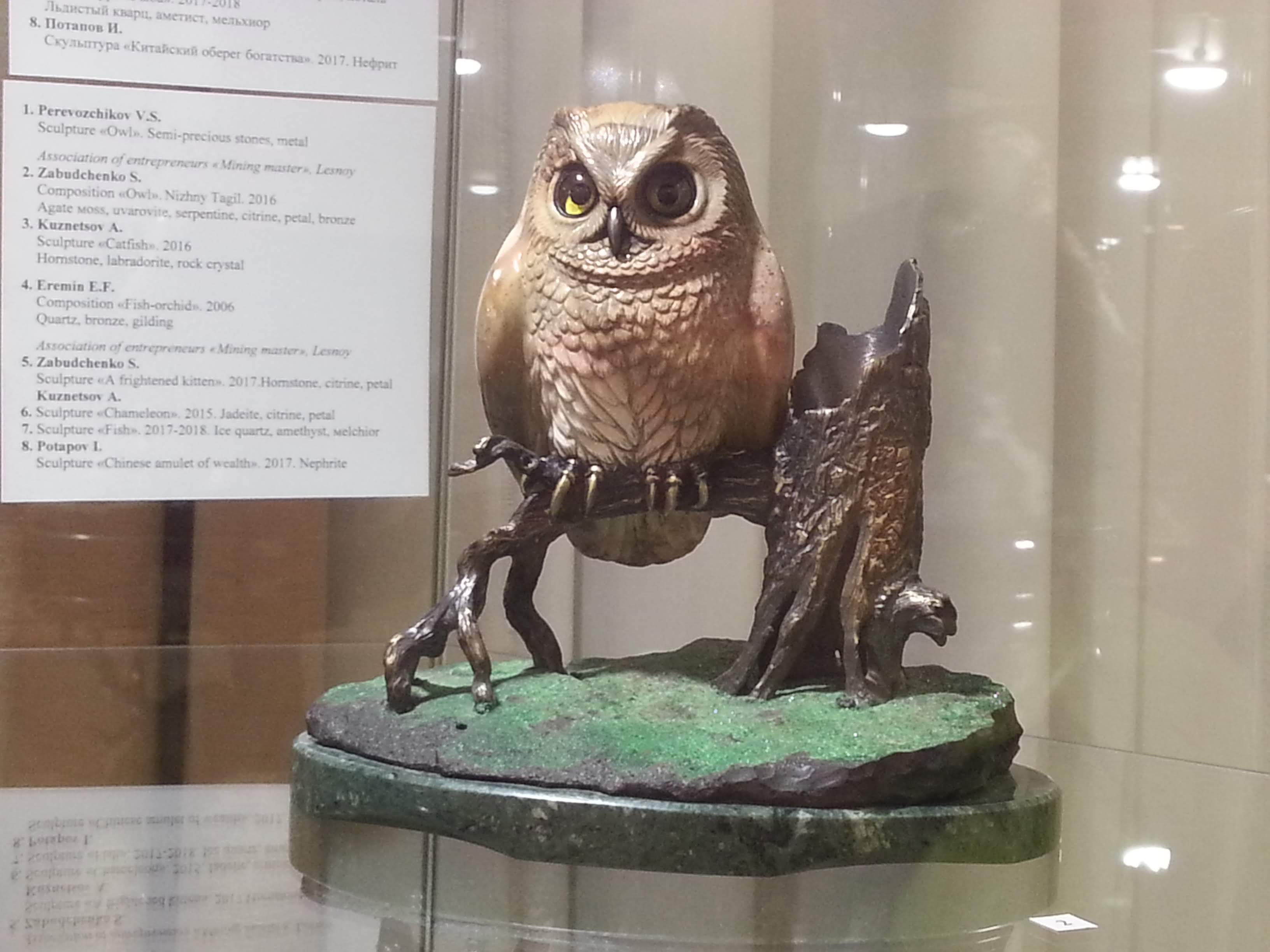
My favorite owl.
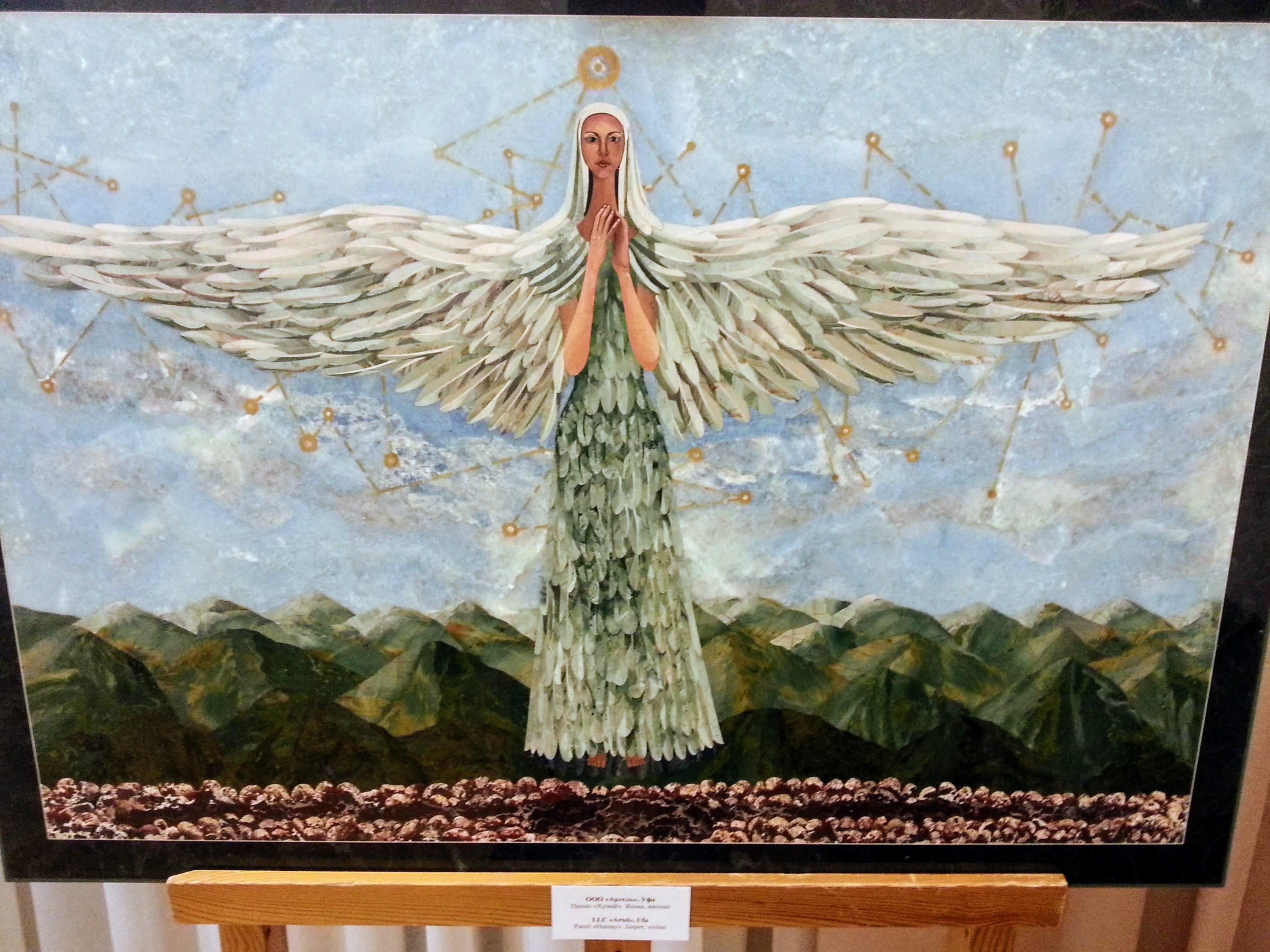
Pictures-panels, laid out from thin pieces of colored stone.
Various collections are regularly brought. As a rule, they are exhibited in the Ekaterinburg Museum of Fine Arts. There is an exhibition of Kasli casting. Very beautiful, skill deserves respect, I recommend to visit.

Among the sports facilities, it is worth noting the stadium, which was significantly updated for the 2018 World Cup.
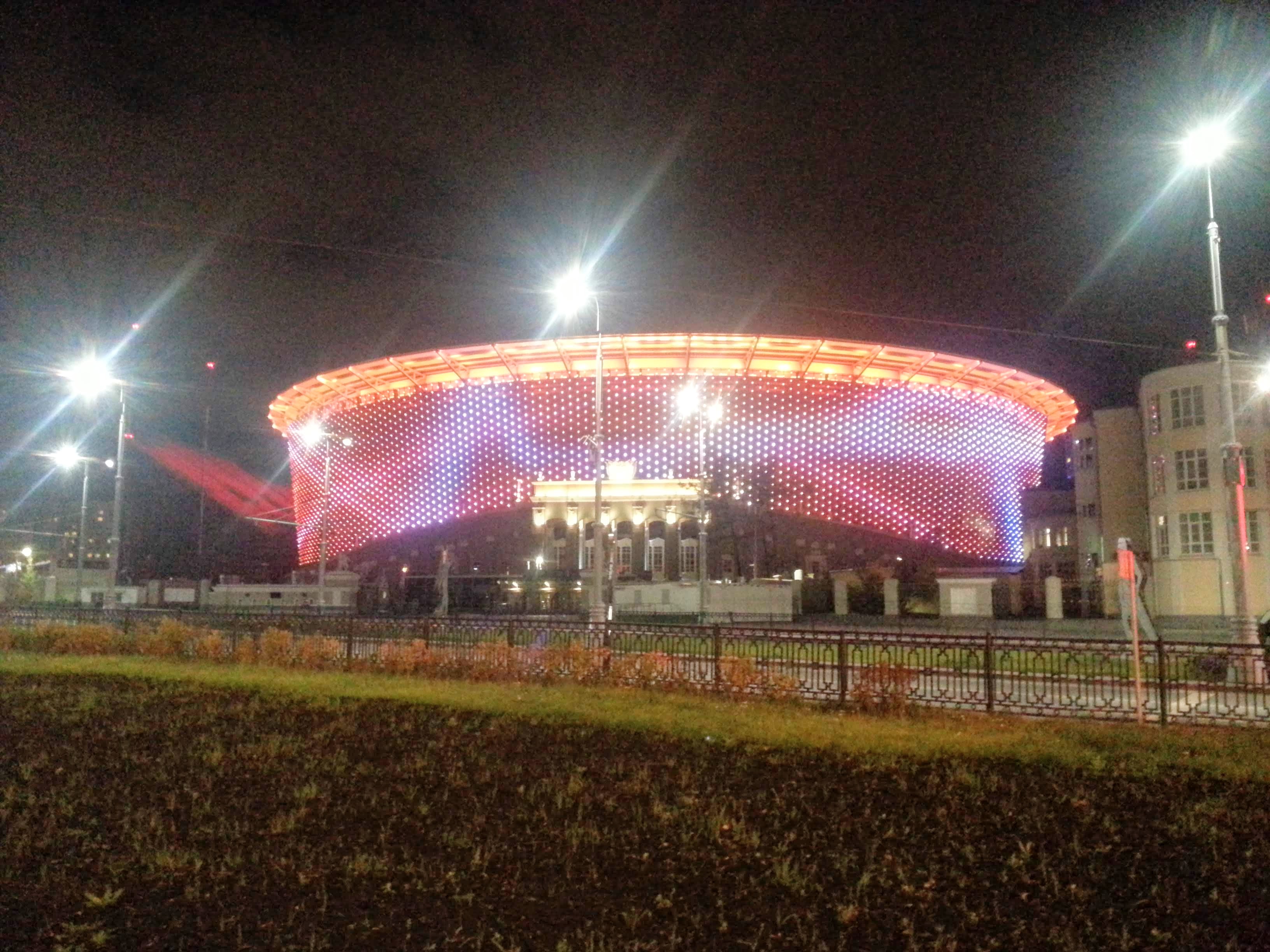
This year, on the day of the city made a great fireworks. It lasted for almost an hour, making him about half a dozen invited teams. Great gift to citizens.
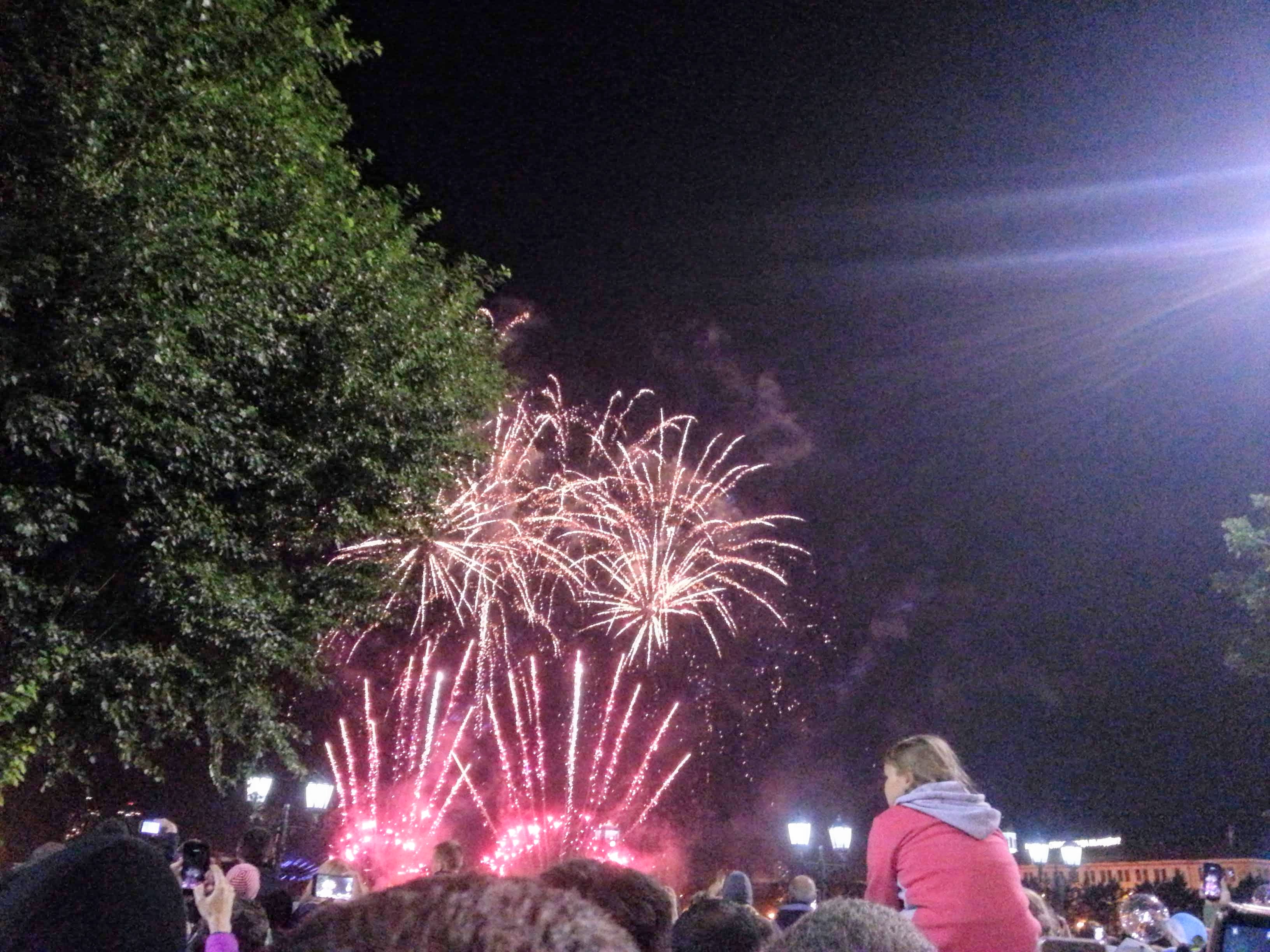
Motorcycles in Yekaterinburg are rare. Perhaps because of the short season. There are almost no mopeds and scooters (the latter, however, are used by couriers, but still very few). Cyclists in the season, to my surprise, many times more. Drivers of cars need to turn their heads, since there are many of them, they are on the sidewalks and on the roads, they behave completely unpredictable.
Housing prices start from 1.4 million for a studio on the outskirts, from 2 million for 1k apartment in the same place, from 2.5 million rubles for 2k, and finally, from 3 million for a three-room apartment in theworlda remote area with difficult transport accessibility (all prices are for new buildings in the high readiness stage). Some time ago, offers began to appear on the level of "Comfort" (or slightly under-fitting) at more or less affordable prices. Previously, offers of this level were simply barrageously expensive. The average price for a “square” is 75 thousand rubles. For those who love country houses, it should be noted that the city is partially in the swamps and peatlands, so the house or the site should be chosen in places of dry. It is good to do this in the spring (when the snow melts), or, conversely, in the fall.
The climate here is temperate: the summer is short and cool, the winter is long, but not as severe as, say, in Siberia. There is not very much snow falling, and a significant part of it falls on the calendar autumn and spring, but considering the local climate, it is still winter. In addition, I have to note a small number of sunny days, compared with the Siberian regions (remember “frost and sun; a wonderful day”? So, this is not about the Urals). In the summer there are more sunny days, but also not a resort. My crafts, previously using solar batteries, now all use batteries. In June, the dawn is at 4 am (sunset 21:55), in December - at 9:35 (16:20). Humidity is almost always high here, so personally I have had a decent shift along the corridor of comfortable temperatures. If in a dry climate, I started to wear gloves strictly at a minus temperature, then I donned a positive one. The wind blows regularly in the city, but I do not consider this a disadvantage - the winds are usually not very strong, but they could blow it off perfectly. More annoying lead sky. From the vegetation - local pines and birches, planted poplars and mountain ash. Rarely plant apple trees, bird cherry, lilac. There are planting spruce. Blue spruces also take root in the local climate, although they are rare.
In general, if you are not afraid of dirt (do you know the phrase “tanks are not afraid of dirt”? They are, by the way, made in the Urals), you are not confused by local salaries and cool summer, then you can move here.
For those who are not ready for such feats, but are interested in architecture, I can say that the city is definitely worth a visit, until the unfortunate builders demolished and rebuilt another dozen architectural monuments that the unofficial capital of the Urals is so rich with.
PS: where the opposite is not indicated - the photos are copyrighted, that is mine.
PPS: the main text was written at night, so with typos and other flaws I ask in a personal - I'll fix everything.
Carefully, under the cut pictures.
Ekaterinburg was founded in 1723, i.e. It is not a very old city, but it is not a young city that would be founded or become large in the Soviet years. In 1917, 71,590 people lived in the city, and during the years of the civil war, the population not only did not decrease, but also grew to 91,000 people (a rare achievement in those times). In Yekaterinburg, a large number of buildings of pre-revolutionary construction, and most of the surviving ones are made of bricks, although wooden architectural monuments are also not uncommon.


This moment can be called positive for lovers of old architecture. It makes sense to come to the city even as a tourist, if you like architecture. But, as usual, the pros and cons are rarely separate, and the disadvantages here are the following: old buildings are regularly demolished, even if they are in a satisfactory condition. And then, worse, on the site of an old building on a street with a two- or three-story building can safely stick a 15+ storey candle. And why, actually, no?


Or maybe on the other side of the street everything is built up with skyscrapers of the beginning of the 20th century? No, there is such a "lamp" building of the Ural Mining Institute of red brick.

By the way, about the red brick. In the city, they love and respect him, and today they often make such monsters out of it that look like a prison for VIP.

Put a candle in 50+ floors? The same can be the same (Vysotsky tower is a confirmation of this).
Offtopic
By the way, the tower has a viewing platform (paid), and two floors below is a good vertical restaurant with reasonable prices and a great view of the city. I prefer to admire these views when it is already dark.


This leads to traffic jams and traffic jams and kills the historic part of the city.
For the sake of construction, Antei demolished a monument of architecture of the 19th century, the Falkovsky manor with a unique glacier cellar. For the construction of Vysotsky, the monument to the house of Yarutin was also demolished, and they did it literally under the cover of darkness - at night, with guards and no one could do anything. This I called what I immediately remembered from memory without google. And this is always the case. There is no architecture left - only BC, shopping and entertainment centers and anthills.
habr.com/post/428826/#comment_19426564
Sometimes it seems to me that the official who issues building permits is either incompetent or unclean. For example, a narrow alley leads to this house. After it is handed over, and people are settled, there will be a pipets twice a day.

What to go far! Once they decided to rebuild the old Passage next to the building of the city Duma. The officials who watch over the construction, carefully counted the number of floors, made sure that there are less floors than the Duma, and gave the go-ahead. As a result, the “renewed” Passage became higher than the Duma. And no one looked at the height of the floors ... and, it seems, these unfortunate officials forgot to count the attic. By the way, he borrowed the facades from the old Passage (pay attention to the left side of the photo, next to the transition gallery), and I had the first association as if I was watching the film “Men in Black”, and then a certain alien pulled on Edgar’s skin . Alas, this is quite common in Yekaterinburg.

(The authorship of the photograph is not indicated, I have taken it from the website Our Newspaper)
The city is considered relatively compact, with over 1,450,000 people living in it, and the population is growing. In terms of population, the city is inferior, in an understandable way, to Moscow and St. Petersburg, as well as to Novosibirsk. The central part of Yekaterinburg was built according to a strict plan, and the city in the center has a rectangular layout. In the new parts of the city, other options are also used - for example, in the northern part of the city (Uralmash and Elmash districts) radial-ring layout is used. The city has a subway, one branch of which connects the city in the meridional direction, connecting the central and exit to the southern part of the city and the northern areas of the city. The city is actively being built (Akademicheskiy, Shirokaya Rechka, Solnechny) and new people are coming and going to the city - most of them from the Sverdlovsk region (the local residents call them “regionalist” with extremely negative coloring) some of the adjacent regional centers (Tyumen, Chelyabinsk, Kurgan), people go from Kazakhstan (but to a lesser extent). However, for locals, all visitors by default are “regionalists” (with the exception of guests from Central Asia). An interesting moment with immigrants and workers from Kazakhstan is that most companies do not know how to apply for foreign labor resources even from the EEU countries. On the other hand, the city is simply flooded with migrants in those positions that do not seem very attractive to the local population: janitors, trade, drivers and conductor of minibuses, security, cleaning, construction - all of them are occupied by people from various solar republics. It is understandable - the average salary in the city is about all visitors by default are “regionalists” (with the exception of guests from Central Asia). An interesting moment with immigrants and workers from Kazakhstan is that most companies do not know how to apply for foreign labor resources even from the EEU countries. On the other hand, the city is simply flooded with migrants in those positions that do not seem very attractive to the local population: janitors, trade, drivers and conductor of minibuses, security, cleaning, construction - all of them are occupied by people from various solar republics. It is understandable - the average salary in the city is about all visitors by default are “regionalists” (with the exception of guests from Central Asia). An interesting moment with immigrants and workers from Kazakhstan is that most companies do not know how to apply for foreign labor resources even from the EEU countries. On the other hand, the city is simply flooded with migrants in those positions that do not seem very attractive to the local population: janitors, trade, drivers and conductor of minibuses, security, cleaning, construction - all of them are occupied by people from various solar republics. It is understandable - the average salary in the city is about On the other hand, the city is simply flooded with migrants in those positions that do not seem very attractive to the local population: janitors, trade, drivers and conductor of minibuses, security, cleaning, construction - all of them are occupied by people from various solar republics. It is understandable - the average salary in the city is about On the other hand, the city is simply flooded with migrants in those positions that do not seem very attractive to the local population: janitors, trade, drivers and conductor of minibuses, security, cleaning, construction - all of them are occupied by people from various solar republics. It is understandable - the average salary in the city is about45 thousand rubles. Nobody will go to depressive places - neither their own, nor others.
As for ecology, I should note that in the north of the city there is a smell of industrial emissions into the atmosphere from the adjacent satellite town of Verkhnyaya Pyshma, in the northeast there are nice places like Isoplit (I don’t know how alive and harmful production there is), eastwards the largest Novosverdlovskaya CHPP and the picturesque ZHBI area, just south of it is “Poultry Farm”, in the southeast direction there is a microdistrict with the harmonious name Khimmash, almost strictly in the South there is a microdistrict Elizabeth, which is on the pollution map air also looks "not very."

the origin is unknown
The air is polluted and omniscient dust, which in the offseason looks like streams of natural dirt. Sources of dirt? Mud on private carriages, construction equipment and trucks, streams flowing onto the roads from lawns in rainy weather, and later, in winter, a certain chemical “Bionord” (TM) that prevents it from finally freezing.


As the former mayor is already joking - the locals have “mud in the soul” (see more photos of #drink). The rest of the townspeople, with the exception of the former mayor, are divided into two types: the former prefer not to notice, the latter call the city “Gryazburg”.
 Photo by Irina Shantarina.
Photo by Irina Shantarina.However, another group of citizens is actively fighting with the latter for the right to glue the plates 5.23.1 with another inscription - “Yamburg”. Some roads (very large including even those connecting adjacent areas) in the city did not see repair since the days of their arrangement. Sometimes those and other activists are taken away by valiant law enforcement officers. By the way, about the rule of law - theft is booming. Especially often steal great. Often there are arson cars. Still, it happens that old houses are burned (for construction, see above), activists are beaten from time to time and they kill just random people. In general, life in the Urals is quite tough, if not to say cruel. About traffic police - they have a couple of favorite places where they “graze”, mostly behind signs 40 km / h. Very rarely, cars from under signs are evacuated from just a few streets. Roads are like normal somewhere, somewhere they remind a washboard (the right lane especially suffers, as an example - Furmanov Street when driving from East to West), somewhere there is a hole in the pit. Lots of cameras. There will be even more. Pedestrians need to turn their heads, but, in general, they pass on unregulated passages (but there will definitely be someone who does not miss it). Some traffic lights are not working, regularly, someone walks right under the wheel or tightly / significantly blocks the intersection while driving, not guessing with the mode of its operation. who will not miss). Some traffic lights are not working, regularly, someone walks right under the wheel or tightly / significantly blocks the intersection while driving, not guessing with the mode of its operation. who will not miss). Some traffic lights are not working, regularly, someone walks right under the wheel or tightly / significantly blocks the intersection while driving, not guessing with the mode of its operation.
Cold water in the city, in different places, ranges from "it is necessary to boil" to "we buy water in the supermarket." I myself live in the center, I buy water in the supermarket. Hot water, where it is, ranges from "good" (this is where water is heated from its own well) to "bad." By bad, I mean incredibly stinking water (and / or brown) that is unpleasant to wash. So far I have not been lucky, and in two of three places the water was just that - smelly. With water quality, in general, everything is bad. Plus, I can note the relatively short seasons off hot water (depending on the area). Boilers here in the apartments set very rarely.
Remote work is good, but what is there to do in Ekaterinburg from work, let's say local? The largest IT employers are just a few firms. The first one is SKB-Kontur. With about 10,000 employees, it has about 1,000 programmers and N hundreds of other IT people. Next - Sberbank (and Sbertech). I don’t know how many developers work in it, but they always openly have 50 or more vacancies for IT specialists of various kinds. Other banks are trying to keep up - UBRD holds open from 20 to 30 vacancies. It may be noted SKB Lab, Point. Other local banks also hire developers. However, what am I talking about only banks? In addition to banks, the city has developed industry (or rather its remains), a little more than this industry in the surrounding satellite cities, so if you are friends with microcontrollers, Simatic and Step7 you do not seem to be the names of programs for weight loss - there is also something to do here. There are other purely IT offices - Naumen, Targem Games (yes, guys make games!), Jet style, Yandex has a small office in the city, INSIS and so on. By the way, for those who would like to try themselves in telecom, MegaFon has a large center of several competencies in the city: Oracle DBA, Unix admins, small RnD teams from large divisions, DWH and others.
The median salary in the city among IT specialists is about 70 thousand rubles. In life, as always happens more, it happens less. Moreover, for the same duties in different companies can pay twice, or even three times different money. But in general, in terms of wages in IT Co., this is not Moscow or St. Petersburg.
On the pedestrian street Weiner, in the heart of the city, there is a local hackspace MakeItLab. The guys are doing cool stuff. They are located in a modest mansion.

Yandex Photo
Culturally, the city is quite rich. The first city theater was built in 1845 of brick and still stands, an excellent building pleasing the eye. Several theaters. Different groups come regularly. There are always interesting announcements on posters. The city hosts the annual rock concert "Lighthouse". There is a philharmonic society (and there is even an organ in it! It's amazing). There are a number of museums. My favorite where I always lead people is the Museum of the History of Stone-cutting and Jewelry Art.

My favorite owl.

Pictures-panels, laid out from thin pieces of colored stone.
Various collections are regularly brought. As a rule, they are exhibited in the Ekaterinburg Museum of Fine Arts. There is an exhibition of Kasli casting. Very beautiful, skill deserves respect, I recommend to visit.

Among the sports facilities, it is worth noting the stadium, which was significantly updated for the 2018 World Cup.

This year, on the day of the city made a great fireworks. It lasted for almost an hour, making him about half a dozen invited teams. Great gift to citizens.

Motorcycles in Yekaterinburg are rare. Perhaps because of the short season. There are almost no mopeds and scooters (the latter, however, are used by couriers, but still very few). Cyclists in the season, to my surprise, many times more. Drivers of cars need to turn their heads, since there are many of them, they are on the sidewalks and on the roads, they behave completely unpredictable.
Housing prices start from 1.4 million for a studio on the outskirts, from 2 million for 1k apartment in the same place, from 2.5 million rubles for 2k, and finally, from 3 million for a three-room apartment in the
The climate here is temperate: the summer is short and cool, the winter is long, but not as severe as, say, in Siberia. There is not very much snow falling, and a significant part of it falls on the calendar autumn and spring, but considering the local climate, it is still winter. In addition, I have to note a small number of sunny days, compared with the Siberian regions (remember “frost and sun; a wonderful day”? So, this is not about the Urals). In the summer there are more sunny days, but also not a resort. My crafts, previously using solar batteries, now all use batteries. In June, the dawn is at 4 am (sunset 21:55), in December - at 9:35 (16:20). Humidity is almost always high here, so personally I have had a decent shift along the corridor of comfortable temperatures. If in a dry climate, I started to wear gloves strictly at a minus temperature, then I donned a positive one. The wind blows regularly in the city, but I do not consider this a disadvantage - the winds are usually not very strong, but they could blow it off perfectly. More annoying lead sky. From the vegetation - local pines and birches, planted poplars and mountain ash. Rarely plant apple trees, bird cherry, lilac. There are planting spruce. Blue spruces also take root in the local climate, although they are rare.
In general, if you are not afraid of dirt (do you know the phrase “tanks are not afraid of dirt”? They are, by the way, made in the Urals), you are not confused by local salaries and cool summer, then you can move here.
For those who are not ready for such feats, but are interested in architecture, I can say that the city is definitely worth a visit, until the unfortunate builders demolished and rebuilt another dozen architectural monuments that the unofficial capital of the Urals is so rich with.
PS: where the opposite is not indicated - the photos are copyrighted, that is mine.
PPS: the main text was written at night, so with typos and other flaws I ask in a personal - I'll fix everything.
